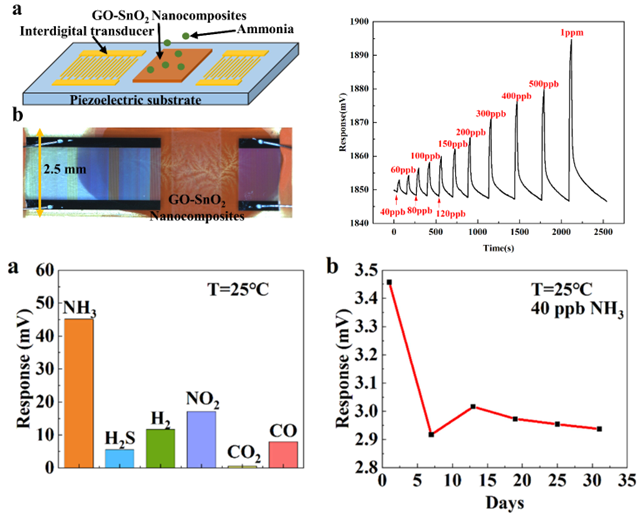Ammonia is a kind of toxic, volatile and highly irritating industrial gas. As a chemical raw material, it is widely used in chemical industries, food processing, and medical fields. The detection of trace ammonia is of great significance for environmental and human health protection and industrial production safety. Existing ammonia gas sensing technology has shortcomings of high working temperature, poor selectivity and slow response speed, which is difficult to meet the actual application requirements.
Researchers from the Institute of Acoustics of the Chinese Academy of Sciences (IACAS) and the Institute of Aerospace Technology of the Chinese Academy of Sciences (AIRCAS) combined micro/nano SAW device technology with GO-SnO2 nanocomposites to design and manufacture a new type of SAW ammonia sensor with a sensitivity of ppb at room temperature (25 Celsius degree).
GO-SnO2 nanocomposite features large surface area and many chemical active sites, which greatly increase the ammonia adsorption efficiency, thereby improving the sensor sensitivity and response speed.
Researchers prepared GO-SnO2 nanocomposites on the surface of acoustic propagation path and constructed a small-scale surface acoustic wave (SAW) ammonia sensor. Combined with the phase discrimination sensing circuit, they tested the developed SAW ammonia sensor experimentally.
The results show that compared with the reported ammonia sensors at home and abroad, the proposed sensor achieves lower detection limit (40ppb), higher sensitivity (0.098mV/ppb) and fast sensing response (<16.4s). In addition, it features excellent selectivity and repeatability, which is very promising in the detection of trace ammonia.
The research, published online in Top Journal Sensors and Actor B-Chem (IF: 9.221), was supported by the National Natural Science Foundation of China (No.11774381, No.62174163) and the National Key R&D Program (No.2020YFB1506205).

Figure. 1 Characterization of GO-SnO2 nanocomposite (Image by IACAS)

Figure. 2 SAW ammonia sensor and its response characteristics (Image by IACAS)
Reference:
Xinyang Sun, Tingting Chen, Yong Liang, Chao Zhang, Shoupei Zhai, Jianhai Sun, Wen Wang, “Enhanced sensitivity of SAW based ammonia sensor employing GO-SnO2 nanocomposites”, Sensors and Actuators B- Chem., 2023, 375, 132884. DOI: 10.1016/j.snb.2022.132884
Contact:
ZHOU Wenjia
Institute of Acoustics, Chinese Academy of Sciences, 100190 Beijing, China
E-mail: media@mail.ioa.ac.cn


